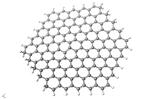How can we break the spell affecting our thinking about carbon? Hearing the word “carbon”, most people have one thing in mind: a black rock that poisons our environment. What can we do to start treating carbon as a chemical element capable of revolutionizing our lives?
We should treat carbon not as a mineral resource that is mined, but as a chemical element that can be used to form different spatial structures: fullerenes, nanotubes or graphene – a material with the thickness of a single atom that has become very popular recently. When analyzing graphene in more detail, we may notice its highly unique features. The hexagonal arrangement of carbon atoms resembles the structure of a honeycomb, with each atom of carbon forming a bond with its three adjacent counterparts. In such a layout, a single unpaired electron is available in each atom of carbon. Those electrons form, within the hexagons, the so-called delocalized bonds that determine the unique properties of graphene.
Where can novel carbon-based technologies be applied? Is it true that they are being designed primarily to satisfy the needs space industry?
It is usually the case that new, highly advanced technologies are firstly implemented in space and arms industries. This is due to the fact that modern solutions require relatively significant financial outlays, as they are often initially manufactured in very low numbers. However, in the case of graphene, laboratory work is being performed in parallel in many areas, including nanorobotics[1], optoelectronics[2] or spintronics[3], as well as in areas related to renewable sources of energy and to its storage. As far as energy generation is concerned, we are talking about flexible photovoltaic cells which, due to their high transparency ratios, may be used as building facade elements or may cover glazed surfaces. Such work is carried out, inter alia, at the Łódź University of Technology, using an environmentally friendly synthesis of graphene quantum dots.
It is said that graphene is one of the materials that have already triggered an industrial revolution. Why graphene? Does it have any unique features?
Very high expectations are associated with graphene, as it is a semiconductor with a zero-energy gap. It is also characterized by high transparency, good chemical indifference, as well as biocompatibility, making it highly suitable for practical applications in many areas of life. Intense work related to the use of graphene in a number of different fields is currently under way. For instance, it is used for designing nanosensors capable of detecting bacterial pathogens. Graphene flakes, in turn, are highly promising as cancer cell markers.
The ability to manufacture ultrathin electronic displays that are as thin as a sheet of paper is considered to offer some truly revolutionizing opportunities as well. Imagine phones, screens or large-surface displays that are so extremely thin. It may turn out that we will experience a technological leap and in a few years’ time the television sets we are used to will become a thing of the past, as they will be phased out by hologram technologies based on graphene electronic circuits.
The search for the so-called “strategic chemical elements” that are of key importance for the development of global economy is under way as well. The problem is that metal prices are currently disproportionately high compare to the cost of their extraction and processing. This is the case for rare earths and lithium. The prices of these elements are elevated by Russia and China, which significantly limits access to such resources and prevents the world from designing advanced electronic systems based thereon. In light of the above, graphene and its functional varieties may be perceived as highly promising alternatives. Research is conducted with the use of material engineering tools that rely on sophisticated chemistry, nanotechnology and metallurgy processes.

Allegedly, we are already capable of using graphene in alternative hydrogen storage systems. Is that possible and why is this important?
We have high hopes as far as the use of graphene for hydrogen storage is concerned. The unpaired electrons that are available in nearly each atom of carbon within the graphene structure play a very important role here. Such systems are capable of acting as reversible hydrogen storage media operating at nearly atmospheric pressure. This eliminates the need for dangerous cylinders containing compressed or liquid hydrogen. Such modern hydrogen storage systems may be successfully used for powering not only cars, but also of trams, trains, ships or spacecraft. The first prototype of such a storage device has already been built and tested at the Institute of Material Engineering of the Łódź University of Technology.
What is crucial in the studies focusing on graphene, so that it can be used on an industrial scale? When will the graphene revolution take place - in 10- or 50-years’ time?
The revolution is already occurring before our own eyes, although it may not be visible to everyone, as it is taking place in laboratories. But the number of people who are directly affected by the potential of graphene-based structures is growing at a fast pace. Of course, one has to be ready for situations in which subsequent discoveries will also lead to abandoning the use of graphene in some scenarios - two-dimensional MXene materials may serve as a good example here[4]. It is beyond any doubt that graphene has opened the minds of scientists and has provided a stimulus for investors, with both of those groups striving to create something that the world has not seen so far. The biggest problem, however, is what can be produced with the use of graphene. Try to list 5 things you think will contribute to the economic revolution. What types of products will you think of? We must disregard improved designs, focusing solely on new inventions. For example, we must not think of a new generation of vehicles, but of a completely new method of transport, such as teleportation. That’s when we are taking about an economic revolution, not an evolution. The world is driven by consumption and by technological game changers.
What does the Polish graphene market look like? Are there any Polish companies focusing on graphene? Can they compete with foreign businesses? Does Poland stand a chance of becoming a significant graphene manufacturer?
I think we can be proud, as Poland has a huge scientific potential at its disposal. Since 2010, when the Nobel Prize was awarded for extracting and testing a single layer of carbon that was several micrometers thin, work on manufacturing such materials has been conducted at several scientific centers located in Poland. The Łódź University of Technology has developed HSMG® - large surface graphene material that is based on a liquid medium. This technology has been patented worldwide and was contributed to a spin-off company known as Advanced Graphene Products S.A. (AGP) - Europe’s leading manufacturer of flaked and surface graphene that debuted on the NewConnect market in November of 2021. Currently, AGP offers a number of graphene-based semi-finished products intended, inter alia, for 3D printing, as an additive for paints, polymers, filters or even advanced batteries that the Łódź University of Technology is also working on. I can reliably state that Poland is one of the world’s leaders in graphene synthesis and application.
How can advanced carbon technologies be supported in order to develop in Poland? Is the path ahead easy? Or full of problems?
The answer is simple and fairly trivial. There is a need for adequate financial resources in order to fully harness the intellectual potential of our researchers. The fact that it is difficult to control the quality of carbon-based systems, to ensure their purity and to guarantee the repeatability of their structures (stable defect ratios) is the main obstacle preventing such solutions from being marketed on a wider scale. Contamination in the range of a fraction of a single percent may significantly affect the properties of the material, e.g. its ability to store hydrogen, capacity of batteries, catalytic properties, etc. That is why the next step allowing us to fine-tune the technology on the level of single atoms is so important.
The funding process must be designed in such a way as to enable scientific centers to access and maintain state-of-the-art research equipment. Sophisticated equipment is very costly (with its prices often exceeding several million zlotys), thus being a major barrier hindering intense technological development.
Numerous projects are being pursued all over the world in which carbon is used to capture and store CO2 generated by different technological processes. These solutions are still very costly, but many experts predict that they may become cost-effective due to technological progress and economies of scale. What is your opinion?
The results are extremely difficult to achieve, especially if we want the process to be economically viable. Ideally, we should abandon thinking about storing CO2, and should switch to finding ways of obtaining clean carbon and oxygen instead. Unfortunately, the energy balance of the process is not positive. The use of energy produced from renewable sources can bring us much closer to achieving that energy balance. If we learn how to master the process of recovering carbon and oxygen, we may be given access to completely new opportunities. As the bonds existing within a CO2 molecule are severed, atomic carbon is created that may be used, in a controlled recombination reaction, for producing perfect structures of chemically clean graphene, nanotubes, fullerenes or their spatial hybrids. This process, for the time being still considered to be “science fiction”, could also rely on bionic tools[5] - in this particular case, copies of mechanisms used for producing spider webs.
Therefore, the problem of CO2 disposal must be considered globally and must be linked with the concept of using breakdown products for synthesizing new, technologically advanced materials, such as nanosensors and nanoprocessors for ultra-fast computers. I am convinced that such an approach will be economically feasible.
Is it true that water, hydrogen and carbon are mutually interconnected resources?
Definitely. The structure of a spatially networked graphene with quasi 2D properties, capable of storing hydrogen in a reversible medium, is a good example here. When placed, in the form of a thin film, on carbon-composite electrodes, the same structure serves as a water filter. Besides, we are talking about prototype solutions that we are developing at the Łódź University of Technology. Imagine that these materials may potentially solve the problem of scarce drinking water resources in Africa. The same water may be used for producing green hydrogen after harnessing the excess energy generated by wind farms.
Water, carbon or hydrogen cannot be considered separately. They create a closed cycle of interrelated processes that share the same properties and applications - with a particular emphasis on environmental protection and economic benefits. So far, these three types of resources have been rarely linked by the industry. We can already see that economically feasible solutions capable of protecting or even repairing the environment are within our reach.
You represent the worlds of science and business. Is it easy to adopt such an approach in Poland? Such cooperation seems necessary to develop innovative solutions, but what does it look like in practice? Is it easy to combine science with business?
I am in a unique situation, as my profession is a source of great pleasure for me. And the people I meet are mostly pragmatic, as they focus on industrial applications of scientific research. Therefore, a few years ago, I became a co-founder of Advanced Graphene Products SA. Taking all that into consideration, I may say that it is relatively easy for me to look at the proverbial laboratory tube and see the potential industrial applications of its contents. My supporting wife often says that I “keep making things up”. Perhaps such an approach is the key to success, as dreams open up new opportunities. However, offering people the opportunity to act and accepting that errors will be made is the key thing here. I am trying to get our freshmen students involved in conducting scientific research. We also have a number of young PhD degree holders facing the prospect of completing their habilitation studies soon. They also have the opportunity to set up spin-off companies - with another daughter company of C Cube that you will soon hear about being a good example here. Let me tell you that its activity will rely on applying modified carbon-based materials in sports yachts that race, inter alia, in the Atlantic.
We have heard that scientists are working on various solutions using graphene, e.g. on electrodes with a graphene layer enhanced by rhenium oxide. It sounds a bit like science fiction, but it turns out that such solutions have a huge potential. Are there any other ways in which carbon may surprise us?
We know very well that imagination is our only limit. The older we are, the less we tend to “fantasize”. Therefore, scientists often rely on young minds and ask children about their vision of the world in 10- or 15-years’ time. With the support of a range of technologies offering a good growth potential, they attempt to create a world seen through the eyes of children. The method was used in the US (Forsight program) for developing key technologies which could revolutionize the world’s economy. The same approach was relied upon for miniaturization of robots and for building a nanorobot the size of a single blood cell that could monitor the health status of our body cells.
Can the bad and disliked carbon save our environment?
I imagine that having read this interview, all of our readers will be able to answer that question for themselves. If not, I am available for further discussions.
[1] A technological domain focusing on designing machines or robots whose components have the size of single nanometers.
[2] A technological domain relying on specific properties of light in order to obtain, collect, transmit, process and present information.
[3] An area of electronics in which changes in current flow and the spin of the electron are relied upon as an information medium.
[4] A group of nanomaterials with a 2D crystal structure, with their properties ranking between those of metals and ceramic materials.
[5] An interdisciplinary science investigating the anatomy and the functioning of organisms, adapting biological solutions to construct technical equipment.

Professor Łukasz Kaczmarek, PhD, graduated from international management studies in the field of Master of Science in Science and Technology Commercialization (MSSTC) carried out on the basis of an exclusive license granted to the University of Lodz by the University of Texas in Austin in the USA. A graduate of the Faculty of Chemistry of the Lodz University of Technology, he defended his doctorate at the Faculty of Mechanical Engineering of the Lodz University of Technology. It deals with the synthesis and functionalization of graphene flakes. He is a co-founder of the spin off company Advanced Graphene Products SA dealing with the production and modification of large-area graphene,which debuted in November 2021 on the NewConnect market. He is the Vice-Dean for Development of the Faculty of Mechanical Engineering of the Lodz University of Technology and the Director ofthe Institute of Materials Science and Engineering of the Lodz University of Technology. He is a member of the Board of the Polish Society of Materials Science.











